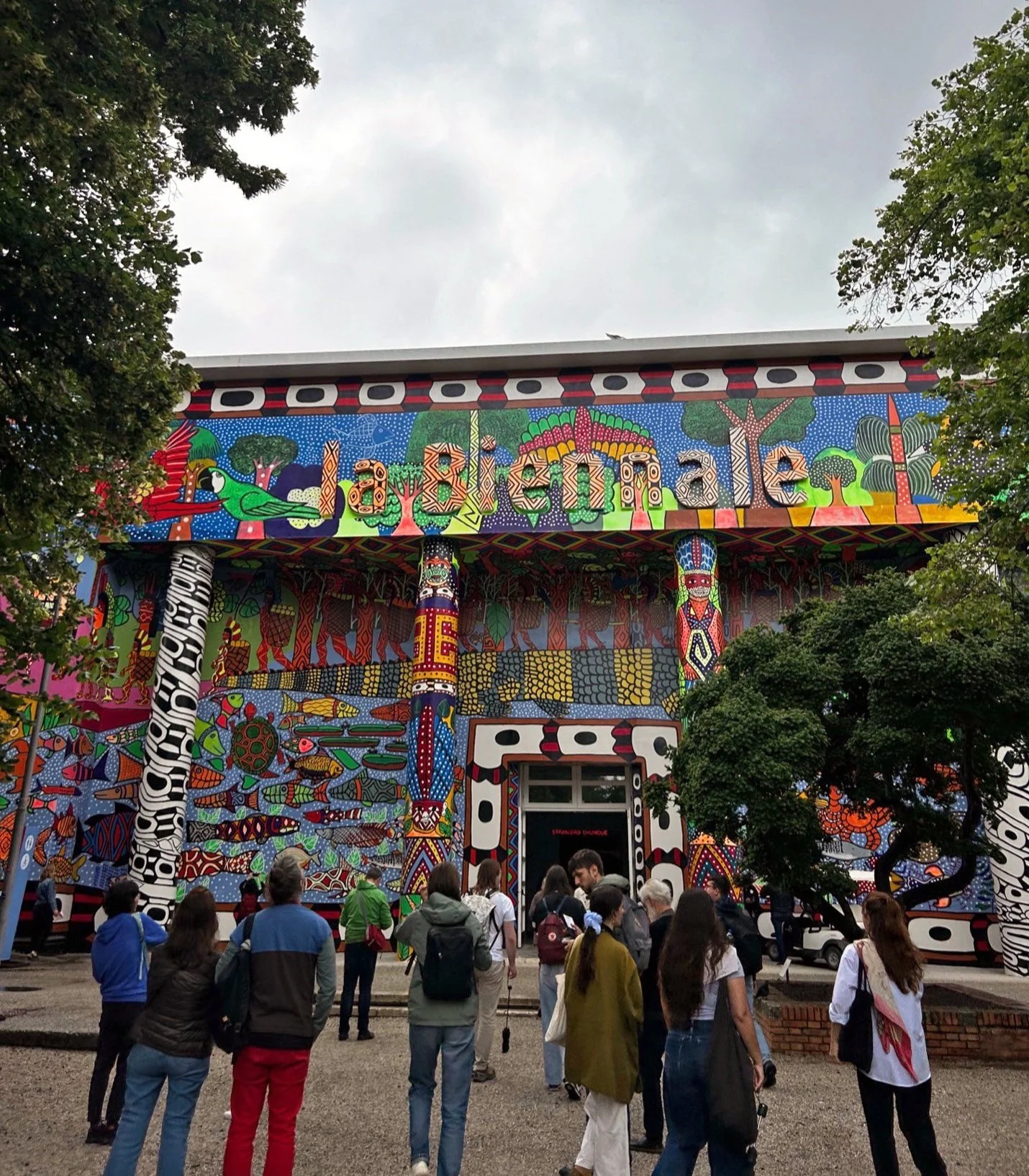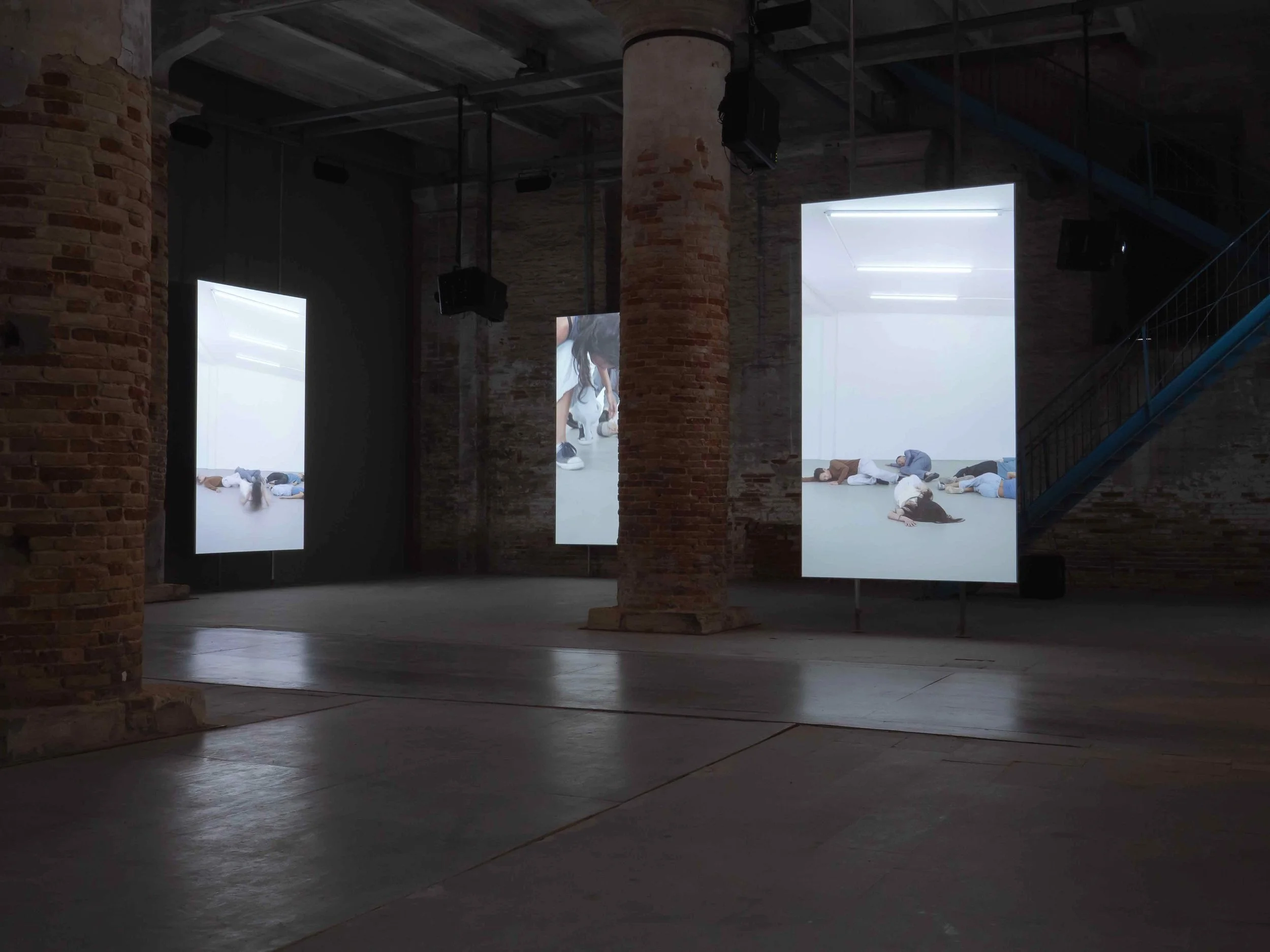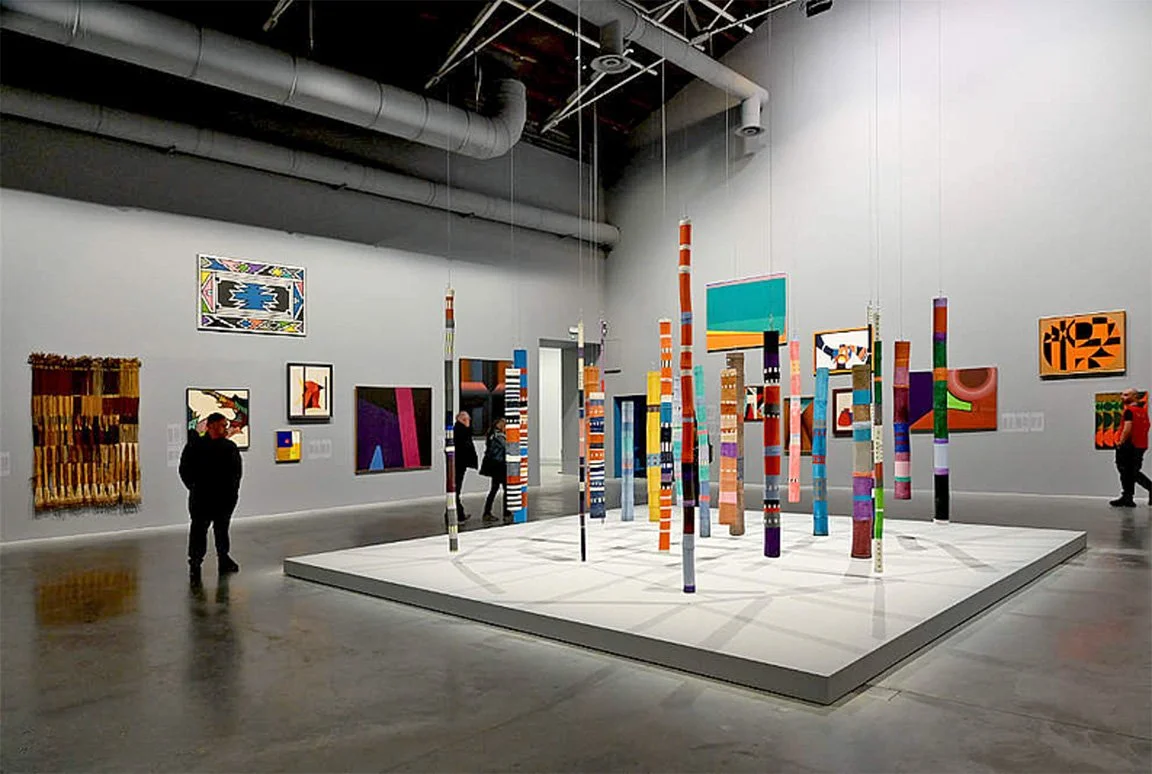Not Foreign Enough: Revisiting the 2024 Venice Biennale
A year after the Biennale’s latest edition, the philosophical and curatorial questions of Otherness and difference implicit in Artistic Director Adriano Pedrosa’s title, Foreigners Everywhere, feel all the more pressing to address.
By Abbas A Malakar
A year after the Biennale’s latest edition, the philosophical and curatorial questions of Otherness and difference implicit in Artistic Director Adriano Pedrosa’s title, Foreigners Everywhere, feel all the more pressing to address.
Abbas A Malakar • 8/1/25
60th Venice Biennale Arte, Stranieri Ovunque–Foreigners Everywhere, April–November 2024
-
On Site is The Curatorial’s section in which writers review exhibitions from a curatorial perspective—not an art review, a curatorial review. This is also a showcase for master’s degree students in the MA Curatorial Practice program at the School of Visual Arts (the home of the journal) to publish as part of the program—though others are welcome to write for On Site as well.
In this review, Abbas A Malakar reflects on the breadth and depth of the sixtieth edition of the Venice Biennale, curated by Adriano Pedrosa. While Malakar found excellence and range in the historical and geographical selection of works, the problematic categorization of the works and their homogenizing display never accomplished a truly nuanced examination of Otherness that the curator promised. Nonetheless, the issues of difference and tolerance invoked by Pedrosa are all the more urgent in a global political climate of authoritarianism and brute nationalism that we face today.
At the 2024 Venice Biennale’s Central Pavilion entrance. Image courtesy Gabriela Valentin Cruz.
It has been a little more than a year since April 20, 2024, when the 60th Venice Biennale opened its many doors. Venice can be overwhelming. The Biennale can add to that effect. Cut off from the rest of the world, surrounded by history crumbling and drowning, one’s ability to feel can be heightened. Running from pavilion to pavilion, and then trying to cover both the locations at the Giardini and the Arsenale, so many emotions are bound to erupt, and intensely so. As such, both appreciation and criticism of the Biennale can, justifiably, reach extremes. A retrospective thinking, removed from the immediacy of those emotions, hopes to be more objective.
Under the curatorial leadership of Adriano Pedrosa, the artistic director of the Museu de Arte de São Paulo, he gave his Biennale the title Foreigners Everywhere. The aim, according to the Biennale’s official website, was to highlight artists who had historically been excluded from the West. The criteria specifically noted those who had never been shown in Venice, referred to by Pedrosa as “the invisible.”1 In this sense, the exhibition projected hope not only for the world of art but for the people of the Global South.
Pedrosa was, to a degree, celebrated by the media prior to the Biennale’s opening.2 The interviews he gave and the way he spoke of his presence as queer and Brazilian seemed to suggest that he thought these an achievement in themselves, as if he might have accepted laurels before the race even began.3 It should be seen as a success that the decolonial forces of the world led to someone like Pedrosa being given such a role. But this was not an award; it was a job, and that job was not executed very well.
Ibrahim El-Salahi, The Last Sound, 1964, Oil on canvas, 47.8 × 47.8 inches. Image courtesy Venice Biennale.
Before I say more critically, though, Pedrosa should be lauded for his exceptionally keen eye. Credit is due to him for both his choice of artists and their works. He chose incredible works across a vast temporal and geographical spectrum: from Bona De Mandiargues (Rome, Italy, 1926–2000, Paris, France) to Horacio Torres (Livorno, Italy, 1924–1976, New York, US); from Iván Argote (Bogotà, Colombia, 1983–lives in Paris, France) to Pablo Delano (San Juan, Puerto Rico 1954–lives in West Hartford, United States); from Semiha Berksoy (Istanbul, Türkiye, 1910–2004) to Ibrahim El-Salahi (Omdurman, Sudan, 1930–lives in Oxford, UK). It was clear that he engaged in a broad range of research and devised a meticulous system of selection, as one would expect for the Biennale, but true to his vision of inclusivity.
Isaac Chong Wai, Falling Reverseley, 2021–2024, variable dimensions. Image courtesy Isaac Chong Wai.
The primary categories of inclusion, in keeping with the announcement of his own identity, were queer, outsider, foreign, distant, and Indigenous. There was also an emphasis on the “uncanny” and the “strange,” adding two more possible categories.4 His curatorial approach inherently included the frame of Otherness that, of course, truly anyone might feel.5 Thankfully, these broad categories, which in themselves are too abstract to be more than sociological boxes to check off, took on a far more concrete character in the works themselves. This was evident in the Chinese artist Isaac Chong Wai’s explicitly queer and monumental performance video installations; the polyester and stainless-steel installation by Bridget Reweti, Erena Baker, Sarah Hudson, and Terri Te Tau of the Mataaho Collective from New Zealand; and the expansive drawings of the self-taught UK-based Madge Gill, populated by hundreds of people and an array of semi-abstract architectural settings. Let alone the multitudinous works from the Global South that offered a vast range of expressions that were more interesting for their differences than for the homogenizing mantle of Otherness, of the “outsider,” as put forward by Pedrosa.
A display of historical abstract works in the Central Pavilion, though full of excellent pieces, indicated no apparent interest in distinctions of cultural origin and how such differences influenced the creation of the works. Image courtesy Haupt & Binder, Universes in Universe.
The inclination toward categorical abstraction that struggles against the particularity of the works on view, then, is a characteristic problem of this Biennale, and in more ways than one. For example, it figured as an organizing principle of the art curated in one of the large galleries of the Central Pavilion that highlighted Pedrosa’s engagement with historical art. Like Otherness, abstraction in art is not one thing; it did not grow from the same seeds across the world. Yet he ended up disregarding all nuances within the various worlds of abstraction to put together a salon-style arrangement of paintings that reduced the local origins and meaning of each across the spectrum. While Ben Davis, in Artnet News, points out that the selection of artists in this section was “wildly unbalanced geographically,” inclusion could never have been complete—and that was not the primary problem here.6 What should have been a principal concern is the effect that the selected works had when hung as they were—and could have had if the effect had been more thoughtfully considered.
Syed Haider Raza, Offrande, 1986, Acrylic on canvas, 39.4 x 39.4 inches. Image courtesy Venice Biennale.
The selection included artists such as Etel Adnan (Lebanon 1925–2021, France), Carmen Herrera (Cuba 1915–2022, US), and Tomie Ohtake (Japan 1912–2015, Brazil)—all brilliant in their own right, having cross-cultural significance and influence. While the range of great artists from around the world was impressive, it was far less so to make their works appear as a homogenized mass. Consider Sayed Haider Raza (1922–2016), one of the greatest painters in twentieth–century India. Inspired by Indian philosophy and Western modes of expression, his geometric abstractions have influenced generations of artists and have continued to be a beacon for those alive today. Given his role in shaping modernity in India and his presence in the global market, his importance is profound. One had to look at his paintings in between glimpses of two other selected abstract paintings, by Freddy Rodriguez (Dominican Republic 1945–2022, US) and Kazuya Sakai (Argentina 1925–2001, US). Between Sakai’s unique visual language of simple shapes in bright contrast and harmonious synthesis, and Rodriguez’s warmer gestural dynamism in a heavier-toned palette, there was hardly the space and time to consider the deep philosophical foundations of Raza’s art, reducing everything to simple juxtapositions of color and form. As Jackson Arn noted in The New Yorker, none of the abstract works, given the number present in that one room, were presented appropriately to engage viewers enough to “bloom in the beholder’s eye.”7
Kazuya Sakai, Pintura No.9, 1969, acrylic on canvas, 51.2 × 51.2 inches. Image courtesy Venice Biennale
In fact, the entire remit of making “the invisible” visible collapses here; the “rebalancing of the art canon toward the Global South” never amplifying meaning, only multiplying an inventory of superficially arranged works. Perhaps it created a new list of names to drop in the parlance of the market. Other than that, the “foreign” gained no sustainable foothold in accommodating a more substantial cultural equity—a deeper sense of Othering, and with it, the beneficence of greater understanding and tolerance.
Dean Sameshima, Anonymous Faggots, 2024. Image Courtesy Gabriela Valentín Cruz.
The Western world has tried many times to make the Global South a more apparent presence in its discourses, and according to Maximilíano Durón, the Biennale’s promise was rooted in the “condemnation of much of our current situation” in a fight against “right-wing governments around the world that seek to strip women, queer people, and immigrants of their rights.”8 A year later, it does seem that Pedrosa’s intention is recognizable in retrospect, yet it comes at the cost of appropriating the gaze that has historically manufactured Otherness in the colonial system from a position of elevated access and power, rendering the grand gesture of acknowledgment empty in its promise.9
At another of the art world’s monumental exhibitions, documenta 11 staged twenty-three years ago, Okwui Enwezor made history by denying the Western idea of the foreigner as exotic, holding symposia around the world in advance, and arguing for precisely a counter-colonialist reorientation of both art history and the market. Though the market managed its usual tentacular capitalist hypnotism, that documenta did not exoticize.
And so, the problem was not with the intention, but with the unfounded confidence that it could be achieved without producing much more explicit knowledge as the foundation for the works presented. Without that fundamental reframing, as Davis remarked, Pedrosa’s inclusiveness could be seen as “just switching gears from superficial dismissal to superficial celebration.”10 His nationality, the color of his skin, his gender, or sexual orientation didn’t matter (and shouldn’t matter) because his work turned toward the enjoyment of a moneyed global public already inclined to broaden its tastes for novelty, inventory, or true cultural enlightenment.
The idea seemed to be that everyone—whether artist or visitor—fell within the classifications of Outsider, no matter who they were or where they were from. This was an exceptional claim on the part of the curator, who wrote that everyone, deep inside, is somehow always alien to their surroundings. It was surely a noble effort to highlight the socially imposed categories that separate some of us, but, of course, the principal shortcoming of any such claim is that it aims to unite a set of unique experiences under a set of general rubrics—as though these disjointed categories in the end are somehow all the same. On the other hand, in a world that is steeped in violence over the contested rights of land, home, and geographical anchors to identity—whether between Israel/Palestine, Russia/Ukraine, or India/Pakistan—such a show rips into the absurdity of the absolute and unquestionable brand of nationality, religion, gender, and all conceivable categories of how we recognize each other.
I have come to respect the curator far more now that Venice is far away—having seen, and felt, the need for such a show to have been organized on the international stage. Beyond the criticism levied against Pedrosa for his organizational miscalculations, we are at a unique moment in history when the ideals he was advocating require desperate attention: those of acceptance, openness, and the understanding of alienation through a realization of the alien within each of us, no matter where we are, where we are from, who we are with, or who we believe ourselves to be.
Ahmed Umar, Talitin (The Third) (2023-34), still from video and performance. Image courtesy Venice Biennale.
There were definitely major successes, such as Sudan-born Norway-based Ahmed Umar’s powerful performance/video installation, Talitin (The Third) (2023-24). New York has seen artists from the Biennale’s contemporary section emerge and shine within the last few months with Salman Toor’s two-part painting, drawing, and etching solo shows at Luhring Augustine, and the installation of Karimah Ashadu’s short film, Machine Boys (2024), at Canal Projects. History may remember Pedrosa’s Venice Biennale differently when the physicality of the exhibition is forgotten and all that remains are photographs, catalogs, memories, and the dozens of previously unknown artists he introduced to the Western canon. If his actions last year truly end up breaking whatever chains we are still bound by, no one will be happier than I.
NOTES
1. Adriano Pedrosa, “Biennale Arte 2024 | Introduction by Adriano Pedrosa,” La Biennale di Venezia, June 22, 2023, https://www.labiennale.org/en/art/2024/introduction-adriano-pedrosa; Gabriella Angeleti, “Curator Adriano Pedrosa Responds to Criticisms of His Venice Biennale Exhibition,” The Art Newspaper - International art news and events, June 10, 2024, https://www.theartnewspaper.com/2024/06/10/adriano-pedrosa-responds-criticisms-venice-biennale-exhibition.
2. Zachary Small, “Can Adriano Pedrosa Save the Venice Biennale? No Pressure,” New York Times, April 10, 2024, Arts section, https://www.nytimes.com/2024/04/10/arts/design/adriano-pedrosa-venice-biennale.html.
3. Kate Brown, “Adriano Pedrosa on His Vision for the Venice Biennale,” Artnet News, April 15, 2024, https://news.artnet.com/art-world/adriano-pedrosa-venice-biennale-2466728.
4. Pedrosa, “Biennale Arte 2024,” https://www.labiennale.org/en/art/2024/introduction-adriano-pedrosa.
5. Sean Burns, “Central Pavilion Review: A Celebration of ‘Outsiders’ That Lacks a Punch,” Frieze.com, January 3, 2025, https://www.frieze.com/article/venice-biennale-2024-review-giardini-central-pavilion.
7. Jackson Arn, “The Dead Rise at the Venice Biennale,” The New Yorker, May 2, 2024, https://www.newyorker.com/magazine/2024/05/13/venice-biennale-art-review.
8. Alex Greenberger and Maximilíano Durón, “The 2024 Venice Biennale: Our Critics Discuss Their First Impressions of a Show Unlike Any Other,” ARTnews.com, April 19, 2024, https://www.artnews.com/art-news/reviews/the-2024-venice-biennale-our-critics-discuss-their-first-impressions-1234703858/.
9. Jean Fisher, “‘Magiciens de La Terre’ in Paris,” Artforum, September 8, 1989, https://www.artforum.com/events/magiciens-de-la-terre-in-paris-194191/.
10. Davis, “'Foreigners Everywhere,” https://news.artnet.com/art-world/foreigners-everywhere-unpacked-venice-biennale-review-part-3-2485132.
-
Abbas A Malakar is an independent curator from Kolkata, India. He is a graduate of the MA Curatorial Practice program at the School of Visual Arts. His practice spans public media, social practices, and storytelling. From cooking to collective zine-making, Malakar’s focus is deeply rooted in the everyday need for communal gatherings and public programming. Along with independent curatorial projects, he contributes writing to IMPULSE Magazine and to his Substack, Not This Curator.








